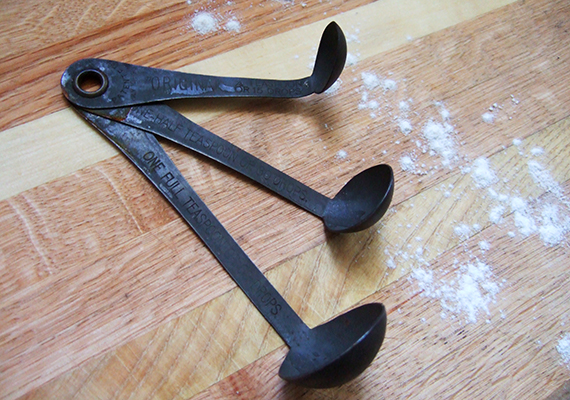My latest Kitchen History for Etsy focuses on the history of recipes–you can read it here. By the time these little spoons were manufactured c. 1900, recipes were orderly and measurements were exact–they look much like a recipe does today. But that wasn’t always the case.
Take a look at the recipe below for Common Gingerbread from Directions for Cookery, in its Various Branches by Eliza Leslie, 1844. It’s such a wonderful window into life in the 1840s–dropping hints on everything to how to process sugar to how professional bakers made gingerbread. It’s almost a novel in the life of a gingerbread.
Is it better, or worse, than a modern recipe? What do you think?
COMMON GINGERBREAD Cut up a pound of butter in a quart of West India molasses, which must be perfectly sweet; sugar house molasses will make it hard and heavy. Warm it slightly, just enough to melt the butter. Crush with the rolling pin, on the paste board, half a pound of brown sugar, and add it by degrees to the molasses and butter; then stir in a tea cup full of powdered ginger, a large tea spoonful of powdered cloves, and a table spoonful of powdered cinnamon. Add gradually sufficient flour to make a dough stiff enough to roll out easily; and lastly, a small tea spoonful of pearl ash melted in a little sour milk Mix and stir the dough very hard with a spaddle, or a wooden spoon; but do not knead it. Then divide it with a knife into equal portions; and, having floured your hands, roll it out on the paste board into long even strips. Place them in shallow tin pans that have been buttered; either laying the strips side by side in straight round sticks, (uniting them at both ends,) or coil them into rings one within another, as you see them at the cake shops. Bake them in a brisk oven taking care that they do not burn gingerbread; scorching sooner than any other cake.
To save time and trouble, you may roll out the dough into a sheet near an inch thick, and cut it into round flat cake with a tin cutter, or with the edge of a tumbler.
Ground ginger loses much of its strength by keeping. Therefore it will be frequently found necessary to put in more than the quantity given in the receipt.
See the original recipe here.


Anyone who enjoys a side of prose with their recipe should search out the 1960 cookbook by George and Berthe Herter, “Bull Cook and Authentic Historical Recipes and Practices.” This eccentric classic is sprinkled with acerbic asides and piquant digressions on nearly every one of its 335 glorious pages. What other cookbook offers “Fish Marie Antoinette,” “Titty Sauce Yams” and a four-page essay on Wyatt Earp’s preference for shotguns over pistols? One of my favorite screeds: “Nowadays you can buy fresh tomatoes nearly everywhere as well as canned tomatoes. We live in a land of the greatest luxuries the world has ever known. A few hydrogen or cobalt bombs could however, put us back to wilderness times in a matter of minutes.”
I’ve never heard of the book! I’m going to look it up:)
Pingback: Reading: “Kitchen Histories: The Measuring Spoon” | The Tart Little Piggy